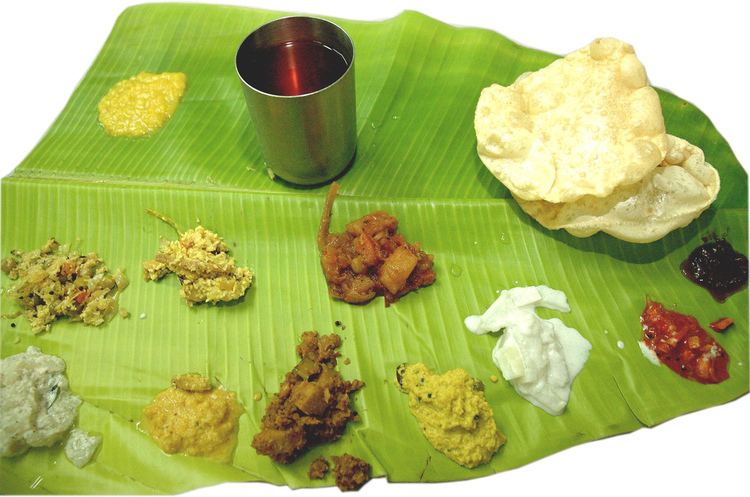Pachadi (Telugu: పచ్చడి, Tamil: பச்சடி, Malayalam: പച്ചടി) refers to a traditional South Indian pickle used as side dish. Broadly translated, it refers to food which has been pounded. In Kerala and Tamil Nadu, pachadi is a side dish curry similar to the North Indian raita, and is made with yoghurt, coconut, ginger and curry leaves and seasoned with mustard.
It is made of fresh vegetables and is served as an accompaniment for rice, snacks like idli, dosa, and pesarattu. Many kinds of vegetables are included. Sometimes the peel of a vegetable is used, such as the peel of ridged gourd known as beerapottu pachadi in Telugu. Telugu (pachadis) are very hot and spicy to taste; the vegetables used are more or less raw or sautéed in peanut oil.
In Andhra Pradesh and Telangana
Vegetable pachadi is made with vegetables like bottle gourd, aubergine, and okra. The vegetable is cooked al dente and is ground with roasted red/green chilis, fenugreek seeds and mustard seeds.
Greens pachadi: The most popular one is Gongura pachadi made out of red sorrel leaves and roasted red chilis. It is unique to Andhra cuisine and is a must have for any meal that gives a taste of Andhra. Other than this, chukka koora (a variety of sour leafy green found in AP) pachadi is also very popular. Chutney is also made out of coriander/cCurry leaves. This is normally consumed as a modati mudda item.
Andhra Pradesh and Telangana are known for hot spicy pickles called ooragaya. A few of the ooragaya items include
Avakaya: The most popular item of Andhra cuisine. It is made of cut green mangos, mustard powder, red chili powder and vegetable oil. It is prepared during April/May, when green mangos are abundant. Every family in Andhra has its own recipe for this pickle based on the variety of mango, chili and the oil used. Like Gongura pachadi, it exemplifies the Andhra cuisine and is a staple of showcase Andhra lunches. For many Andhrites, it is a must have side dish with any pappu item. Mudda pappu (cooked toor dal) and avakaya combined is a staple in most households. There are umpteen varieties of avakaya — with or without garlic and depending on the other ingredients used like pesarakaya (avakaya with moong dal powder), menthi kaya (avakaya with fenugreek powder), neeti kaya (avakaya made by grinding mustard paste with water).
Magaya/Manga: Like Avakaya, this is made during the summertime. Mangos are cut, marinated in their own juice, dried and then mixed with their juice combined with chili powder, methi powder and seasoning. It is a very popular pickle in the coastal Andhra region. For some people it is a must have side dish with yogurt (curd) rice.
Dosa Avakaya: Avakaya made with English (yellow) cucumber. Serves as a substitute for the regular avakaya toward the end of the season. A staple served during winter marriages when raw mangos are not readily available. Recent times have seen cauliflower avakaya become famous. The English cucumber is replaced by cauliflower in this version.
Tomato: A relatively new (19th century) addition to the wide range of Andhra pickles. Made in the winter by marinating tomatoes in their own juice, drying and then mixing them with the juice, chili powder, methi powder and seasoning.
Korivi Kaaram is the spiciest pickle. It is made by grinding ripe red chilis (pandu mirapakaya) with tamarind and salt. Pandu mirapakaya is grown in abundance in the palnadu region of Andhra Pradesh (Guntur district and the surrounding areas). This variety is very famous for its spice and color. A few modifications include combinations of pandumirapakaya with gongura or pandumirapakaya with raw tamarind fruit (chintakaya).
Chintakaya is made by grinding raw tamarind fruit (chintakaya) and salt. It is made during the winter. The marinated pickle is taken in small quantities and is made into a chutney with roasted red chilis when consumed.
Nimmakaya is made by marinating Indian Key lime in its own juice for a few days and then mixing it with salt, methi powder and chili powder.
Usirikaya(Amla) is made by grinding Indian gooseberry and salt. The pickle is marinated throughout the year, picked in small quantities whenever needed and is made into a chutney by grinding it with roast red chilis. Most people avoid consuming Indian gooseberries at night. Saying the name in the night (usirikaya) is also a taboo and is prominently called nallakaya. The trees are revered as abodes of Vishnu and are worshiped in the month of Karthikam (October/November). Eating a meal consisting of raw gooseberry chutney sitting under the Indian gooseberry tree is a tradition during these months.
Dabbakaya, a lesser-known pickle to the current generation, is made out of Indian grapefruit. It is typically consumed as a modati mudda item.
Buttermilk mixed with the tender dabbakaya leaves (dabbaku majjiga) is supposed to quench extreme thirst during the hot summer months.
In Kerala and Tamil Nadu
In Tamil Nadu, pachadi is eaten fresh and typically made of finely chopped and boiled vegetables such as cucumber or ash gourd, with coconut, green or red chillis and tempered in oil with mustard seeds, ginger and curry leaves. Pachadi is commonly eaten with rice and a lentil curry.
In Kerala, the above-mentioned sour Raita-like version of the Pachadi is referred to as Kichadi. In contrast, the Kerala definition of Pachadi is typically a sweet variant of the Tamil Nadu one, made with pineapple, grapes or pumpkin. Many varieties made of the same key recipe exist in different parts of Kerala. It is served at restaurants along with Vegetable Thali Rice. It is also included with Sadhya, especially with Kerala Sadhya popular during Onam and Vishu festivals.

